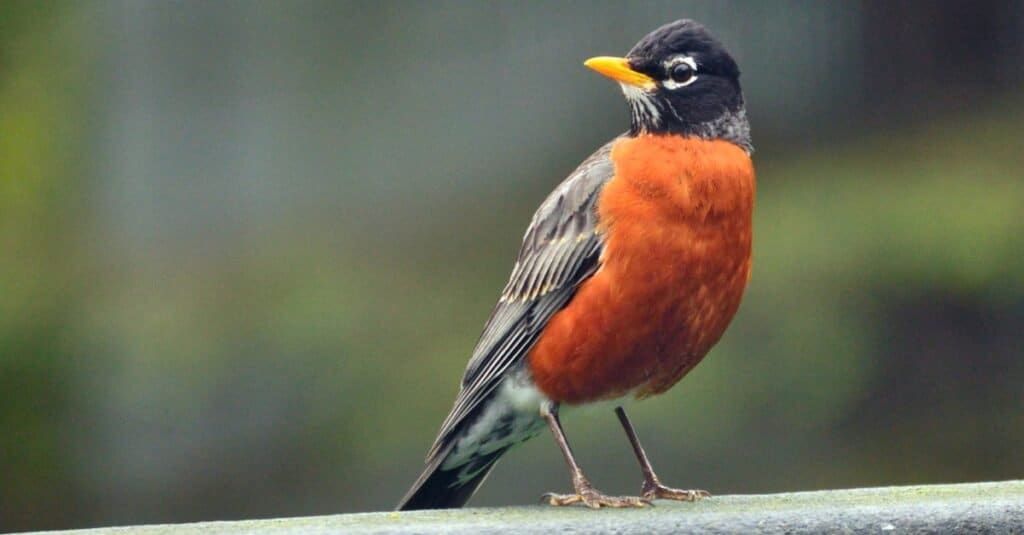American Robin
.jumbotron {
background-image: url(“https://a-z-animals.com/media/2021/09/American-robin-header-400×300.jpg”);
}
}
@media only screen and (min-width: 641px) and (max-width: 920px) {
.jumbotron {
background-image: url(“https://a-z-animals.com/media/2021/09/American-robin-header-470×370.jpg”);
}
}
@media only screen and (min-width: 921px) {
.jumbotron {
background-image: url(“https://a-z-animals.com/media/2021/09/American-robin-header.jpg”);
}
}
American Robin
Turdus migratorius
The color “Robin egg blue” is named after the hue of their eggs.
American Robin Scientific Classification
- Kingdom
- Animalia
- Phylum
- Chordata
- Class
- Aves
- Order
- Passeriformes
- Family
- Turdidae
- Genus
- Turdus Linnaeus
- Scientific Name
- Turdus migratorius
Read our Complete Guide to Classification of Animals.
American Robin Conservation Status
American Robin Facts
- Prey
- earthworms, caterpillars, grasshoppers, beetle grubs, spiders, and snails
- Name Of Young
- fledling
- Fun Fact
- The color “Robin egg blue” is named after the hue of their eggs.
- Estimated Population Size
- 310 million
- Biggest Threat
- pesticides
- Most Distinctive Feature
- orange chest
- Wingspan
- 12-16in
- Incubation Period
- 12-14 days
- Litter Size
- 3-5
- Habitat
- woodland, shrubland, and residential
- Predators
- birds of prey, snakes, and cats
- Diet
- Omnivore
- Type
- bird
- Common Name
- American robin
- Number Of Species
- 7
- Location
- North America
- Nesting Location
- tree forks and dense shrubs
- Migratory
- 1
This post may contain affiliate links to our partners like Chewy, Amazon, and others. Purchasing through these helps us further the A-Z Animals mission to educate about the world’s species..

Spiders that fly! Fish that walk! And 1000+ more incredible animals. Discover them all for FREE
.photo-gallery {
–margin: 0px auto 0px;
–padding: 0px 0px 0px 0px;
}
.gallery-link {
background-image: url(“https://a-z-animals.com/media/2021/09/American-robin-and-babies-1024×535.jpg”);
background-repeat: no-repeat;
background-size: cover;
background-position: center;
height: 500px;
justify-content: center;
text-align: center;
align-items: center;
display: flex;
border: 2px solid #000;
}
.gallery-link img {
height: 50%;
}
@media only screen and (max-width: 768px) {
.gallery-link {
height: 300px !important;
}
}
View all of the American Robin images!
“Most widespread and abundant thrush in North America”
The American robin is a songbird in the thrush family. Thrushes are commonly referred to as “heralds of spring.” American robins have a positive relationship with humans. They are a friendly species that can help control pests. They also benefit the ecosystem by dispersing seeds from the fruit they eat.
4 Incredible American Robin Facts!
- The American robin is the official state bird of Wisconsin, Michigan and Connecticut.
- In the wild, their average lifespan is about two years. However, one individual lived to be almost 14 years old!
- American robins roost in groups of 20 to 200 individuals.
- Cowbirds plant their eggs in American robin nests regularly, but the robin consistently rejects them.
Where to Find American Robins
On the continent of North America, American robins reside in the United States, Canada, and Mexico. They live in a temperate climate in woodland and shrubland habitats as well as open land areas. They commonly have habitats in residential areas also. You can find them in the grass foraging for food when they are not roosting or nesting in trees. You may see them in lawns and gardens, farm fields, city parks, and wooded areas.
button.pulse {
transform: scale(1); animation: pulse 2s infinite;
box-shadow: 0 0 0 0 rgba(11, 247, 25, 1);
}
@keyframes pulse {
0% { transform: scale(0.90); box-shadow: 0 0 0 0 rgba(11, 247, 25, 0.5); }
60% { transform: scale(1); box-shadow: 0 0 0 15px rgba(11, 247, 25, 0); }
100% { transform: scale(0.90); box-shadow: 0 0 0 0 rgba(11, 247, 25, 0); }
}
The best time of year to find this bird relies heavily on the location. Since they migrate, they are found in different areas depending on the season. However, they are active all year long.
American Robin Nests
Females build the nests with no help from her partner. She gathers twigs, grass, feathers, and paper to form the outside structure of the nest. She lines the nest with mud to hold it together. The inside is cushioned with soft materials including grass and other plant matter. When finished, the nesting structure is about three to six inches tall and six to eight inches wide. The nest is located either in the fork of tree branches or in a dense bush. It is typically placed a great distance from the ground, between 4.9 and 14.8 feet high.
Scientific Name
The American robin’s scientific name is Turdus migratorius. It is in the thrush family, Turdidae, and the Aves class. Aves is a class of birds. The origin of the scientific name comes from the Latin words “turdus” meaning thrush and “migratorius” which means to migrate.
There are seven American robin subspecies. The subspecies are eastern robin (Turdus migratorius migratorius), northwestern robin (Turdus migratorius caurinus), southern robin (Turdus migratorius achrusterus), western robin (Turdus migratorius propinquus), Mexican robin (Turdus migratorius phillipsi), Newfoundland robin (Turdus migratorius nigrideus) and San Lucas robin (Turdus migratorius confinis).
American Robin vs English Robin
The English robin formally named the European robin, is where the American robin got its name. Early settlers noticed it had similar features to the European robin, mainly the appearance of its red-orange breast. This, however, seems to be the only comparative similarity between the two birds. These species are not closely related. Though they share the same order and class, they belong to different families.
The English robin is native to Europe and is part of the Muscicapidae family, also referred to as Old World Flycatchers. The American robin is actually a thrush that belongs to the Turdidae family. American robins’ anatomy is different so they are also larger than their European lookalikes.
Size, Appearance & Behavior
American robins are between eight and 11 inches in length and weigh 75 to 77 grams. They have a wingspan of 12 to 16 inches. Their anatomy is typical of a thrush. Their anatomy features include feathers, wings, and a beak. The beak is yellow and the throat is striped black and white. The head is black and the back is gray or black. The chest is a vivid orange color. Males are usually somewhat larger than females and have more colorful features.
These birds exhibit social behavior. They tend to live in small groups and flock in larger groups at night. They are diurnal, therefore they are most active during the day. They sing a melodious song. It is often one of the first bird songs you hear in the morning.

American Robin Migration Pattern & Timing
These birds are fully migratory. They migrate in flocks in the daytime. In the winter, they fly south. In the spring, they head north. In the fall, their migration depends on where there is a decent food supply available.
Diet
The American robin is an omnivore. It eats both plants and animals. It forages on the ground throughout the day and will also forage at night. About 60% of their diet consists of fruits and berries and these foods are especially important in the winter.
What does an American robin eat?
Aside from fruits and berries, an American robin eats a variety of invertebrates such as earthworms, caterpillars, grasshoppers, beetle grubs, spiders, and snails.
Predators, Threats & Conservation Status
Because American robins frequently spend time in residential backyards, they are sometimes indirectly poisoned by pesticides used by humans and killed by pet cats. They are also preyed upon by several animals in the wild.
The American robin’s conservation status on the IUCN Red List is the least concern. The species is stable. Poaching was a problem in the past. They were hunted many years ago but they are now protected by the US Migratory Bird Act.
What eats the American robin?
Other than domestic cats, American robins are eaten by birds of prey and snakes. Some birds that prey on American robins are hawks, eagles, snowy owls, and northern pygmy owls. Snake species that regularly eat them include rat snakes and gopher snakes. American robin eggs and young have additional predators due to their vulnerability. Some common animals that eat eggs and chicks are raccoons, squirrels, foxes, crows, common ravens, and blue jays.
Reproduction, Young & Molting
The breeding season for American robins occurs between April and July. Reproduction is viviparous. The courtship behavior of the male is meant to attract a mate. He shakes his wings, spreads his tail, and sings for her attention. The female usually lays between three and five light blue eggs. It takes 12 to 14 days for the eggs to hatch. When the chicks hatch, they are altricial. This means that they are not independent and require care and feeding from their parents. The chicks leave the nest and begin fledgling about 13 days after hatching. It generally takes them two weeks to get good at flying and be able to sustain flight.
Their average lifespan is two years and they molt once a year.
Population
The estimated American robin population is about 310 million. Roughly 79% of them are in the United States, 45% are in Canada and 13% are in Mexico. These birds have a huge range and are abundant. The population trend is increasing and there is no current threat to their decline. Their conservation status is the least concern.
View all 127 animals that start with A
American Robin FAQs (Frequently Asked Questions)
Does the American robin migrate?
Yes, it does migrate.
How many eggs does an American robin lay?
It lays between three and five eggs on average.
How fast does an American robin fly?
It can fly 20 to 36 miles per hour.
What is the American robin’s wingspan?
The wingspan is 12 to 16 inches.
When do American robins leave the nest?
They leave the nest at 13 days old.
Where do American robins live?
American robins live in the US, Canada, and Mexico.
Are American robins friendly?
Yes, they are friendly songbirds.
Are American robins aggressive?
They are only aggressive when defending their nest and young.
What does the American robin eat?
It eats invertebrates, fruits and berries.
What does an American robin sound like?
The song of an American robin is described as sounding like “cheer up, cheerily, cheer up, cheerily.”
What is the difference between male and female robins?
The main difference between male and female robins is that male robins have darker coloration while females retain more ‘dull’ coloration.
Sources
- eol, Available here: https://eol.org/pages/45510233
- IUCN red list, Available here: https://www.iucnredlist.org/species/103889499/94186470
- Cosley Zoo, Available here: https://cosleyzoo.org/american-robin/
- Audubon, Available here: https://www.audubon.org/field-guide/bird/american-robin
- The National Wildlife Federation, Available here: https://www.nwf.org/Educational-Resources/Wildlife-Guide/Birds/American-Robin
- Brittanica, Available here: https://www.britannica.com/animal/American-robin
















